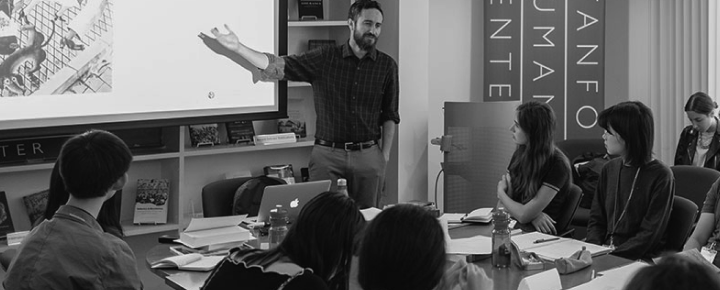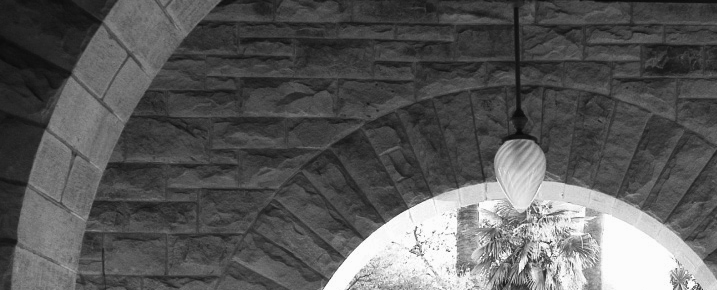
It's weird how in the "post-postmodern" era (as Jeffrey Nealon has a ruefully called it) what counts as modernity remains so attached to the styles of modernism, a formal signification of newness long after these styles could conceivably be thought of as new (that is, long after they became styles).
The modernist aesthetics of Apple are well documented.
Aaron Betsky argued in 2012 that "the company that has already done more to bring the notion of clean lines, abstraction, white, and every other surface attribute of Modernism to the masses than any architect or architectural theoretician." (There's modernism as style again, or even simply as brand—a list of formal features or "surface attributes" to be checked off a list, rather than a philosophical or political engagement with historical modernity.)
Lori Emerson notes that even Apple's "flagship store in New York City, which has been made to appear as if it’s within a glass cube (made of nonreflective glass to create an even more convincing illusion of a marvelous, even pure, reality) that sits above ground, when in fact the store is underneath."
And in 2011 Blake Gopnik complained in Newsweek that "I may be in love with my new Air, but giving it a prize in 2011 is like giving a rave to contemporary paintings that rehash Mondrian’s grids. For me, Apple’s modern styling is like work by Chippendale and Tiffany: you may love it, but you know your love is stuck in the past."
The joke's on Gopnik, of course; he concludes that Apple's design endgame is pure featurelessness, a design so recessive that it appears as pure function—but there's nothing so modernist as a claim to stylelessness.
The fantasies of purity that animate this style, now applied to the laptop I'm writing on, can certainly no longer be read as a resistance to the mass or to mass production, a sentiment that crops up in the Austrian modernist architect Adolf Loos's famous and weird repudiation of kitschy ornaments, "Ornament and Crime." (That resistance's reputation has taken a beating in the last several decades anyway.)
Naomi Schor reads Loos as making a fundamentally economic, not aesthetic, judgment about frills and baubles: "it is a crime against the national economy that [in fashioning ornaments] human labour, money, and material should thereby be ruined."
By the way, Loos definitely isn't arguing for an Arts-and-Crafts-style return to artisan decoration; rather, he argues that mass production liberates us from the laboriousness of ornament and thereby lets us see how superfluous ornament is.
Unadorned aesthetics, here, are no more than an alibi for the supremacy of the economic principle. In that sense, the mass production (safely elsewhere, out of sight) of modernist Apple machines is an apotheosis of the version of modernism Loos seems to propose.
My comparison between Loos's "Ornament and Crime" and Rob Rinehart, the inventor-marketer of Soylent, is a bit gratuitous, but not just. Rinehart's minimalism shares with Loos what turns out to be not mere style, but a form of historical engagement after all—in the sense of a deep investment in one's own modernity and, indeed, futurity.
By the way, I'm very persuaded by Aaron Bady's reading of "How I Gave Up Alternating Current" as science fiction, and not at all the less for Rinehart's apparent sincerity.
It's the kind of futurity that depends on someone else being behind, as Loos discloses from his opening sentence: "The human embryo in the womb passes through all the evolutionary stages of the animal kingdom." He'll go on about development in babies and others for a good two paragraphs, concluding with the assertion that any modern person who self-ornaments by getting a tattoo is degenerate, out of phase with their developmental stage (and out of phase in a particular way—backward), and without question literally a criminal: "If someone who is tattooed dies at liberty, it means he has died a few years before committing a murder." (Hence "Ornament and Crime.")
The developmentalism here is thoroughgoing, but notice how Loos starts out with the human embryo as a sort of model system for every other kind of development (which is imagined as highly normative, teleological, and of course concluding with Loos himself). To begin with, Loos rehearses the popular (but basically wrong) notion that "ontogeny recapitulates phylogeny," but the parallel between human development and evolution soon spreads to a developmental theory of culture and, indeed, of race, which requires "the Papuan"—paralleled, again, to the child—as a figure of primitivism against whose perfectly natural tattoos he can hold up the degenerate, criminal tattoos of the (white) "modern adult."
In a course I teach, "Modernism and Childhood," we spend a good amount of time thinking through the ways that various early twentieth-century thinkers (Freud being a prime example) rely on these parallel developmentalisms, using each "primitive" exemplar (the child, the animal, the racially other) as figures and explanations for the others. That's what Loos is up to here. Beliefs about the child—whose relative disempowerment is profoundly naturalized—enable beliefs about many other kinds of processes.
It probably won't have escaped your attention that this modernity is actually less about time than about hierarchy; Adolf Loos hasn't been around any longer than "the Papuan" (nor is he any younger), but somehow he's ahead. Aesthetics—plain style—is his proxy for time rightly met (which is in turn, as Schor argues, a proxy for economic incentives rightly met).
Rinehart's technological futurism is equally about imposing hierarchy, peppered with oddly melancholic refusals of reproductive labor,
Thoroughly infused by what Dipesh Chakrabarty calls "historicism," in the specific sense of the the temporalization "first the West, then the rest," Rinehart's narrative cleanly (so to speak) encapsulates the interarticulation of modernist plain style qua style and post-postmodern, just-in-time capitalism.
This brings me to Google.
Yesterday, Google announced its restructuring under a new holding company, called Alphabet, of which the G for Google would become just one of many letters.
The original Google product, the search engine, has a famously minimal UI design. Here's how a writer for FastCoDesign described it in 2014:
Arguably, there's no better example of efficient web design than the Google homepage. Every little design tweak goes through rigorous A/B testing, and yet the homepage does not look fundamentally different than it did 10 years ago. In fact, it's so simple and iconic that, back in May, lead Google homepage designer Jon Wiley told us that he wasn't sure if the design would ever fundamentally change.
Efficient! Rigorous! Simple! Iconic! Timeless! So far so modernist. But Google's simplicity doesn't go for sophisticated (read: adult) simplicity in the way that Apple's design so openly does.
Contrast this with the conscious citation of children's alphabet books in the title of Google's Alphabet announcement, "G Is for Google." With its logo in primary colors, the letters in a serif typeface as if on toy letter blocks, and of course a name that's nearly a gurgle and a corporate headquarters (the "Googleplex") that's a pun, Google has never exactly gone for the grown-up look. On the contrary, they are, like Facebook, famous for ping-pong tables in the workplace and Silicon Valley's "youth culture."
One of Google Search's most famous features, in fact, is an ornament: a fast-rotating (24-hour) decoration on the homepage, usually a drawing or an animated cartoon, or sometimes a game, always topical and never repeated, called a "doodle." Google itself describes the doodle feature as "the fun, surprising, and sometimes spontaneous changes that are made to the Google logo to celebrate holidays, anniversaries, and the lives of famous artists, pioneers, and scientists," and, I am not making this up, the first one was made to mark Burning Man. Thus the "simple and iconic" Google Search page is frequently ornamented for amusement ("fun") in just the way that Loos describes in the child and the primitive.
That is not to say that Google's design strategy is antimodernist. Not at all. For the childishly-named doodles don't register as ornaments without the "simple and iconic" reputation of the default search page. More to the point, though, the performance of childishness is a key form of modernist primitivism, a way of superseding modern civilization's (supposed) hypercontrol, not by admitting to being decadent or regressive but rather by appropriating a position of genuine newness in the form of youth (which is also, of course, a proxy for other alleged developmental earlinesses—modernists like Gertrude Stein and William Carlos Williams freely appropriated African-American, Native American, and immigrant positions).
It's interesting that Google entrenches in this self-presentation as infantile and unthreatening precisely in the act of basically announcing itself to be en route to multiplying itself 26-fold, which is, let's face it, terrifying.
This has something to do with what I've elsewhere called "puerility," although I don't think it's quite as complex in Google's case. (Soylent, on the other hand, I see as thoroughly partaking of a puerile politics, seemingly enthusiastically running headlong into utopianism while sipping on a food replacement literally named after one of those sci-fi morality tales that reveal the terrible cost of a popular, futuristic tech solution—in this case, famously, "Soylent Green is people.")
It's not that Google/Alphabet's design can be classed as "modernist" in the way that Apple's can; rather, their seemingly opposing design strategies draw on two sides of the same idea. For example, the names the two companies chose for their respective web browsers—Google's Chrome and Apple's Safari—temporarily reverses the polarity between shiny modern surface and primitivism that each brand usually evokes.
Sianne Ngai has brilliantly elaborated "the cuteness of the avant-garde," and perhaps that cuteness, with its violent undertows, helps explain what is happening in the transition from Google (the rounded letters, the repetitive bisyllable that pushes the mouth into a sucking motion) to Alphabet (the Greek word that literally starts you saying your ABCs).
The danger with cuteness is to read it as a form, rather than as the formalization of a temporal concept, a transformation that the concept of "the child" routinely enables.
These temporal aesthetics, Google's included, tell us something about the repurposing of modernist style for post-Fordist capital. Modernist style still succeeds in evoking newnesses even when wholly "unoriginal" because it so successfully dehistoricizes.
Consequently, the study of early twentieth-century style can be understood as neither irrelevant nor innocent. The quasi-Darwinian, developmentalist ideologies of Silicon Valley have their correlates in styles that disguise their basic violence as design. Its results are, among other things, political transformations of the Bay Area that seek to do to San Francisco what Rob Rinehart did to his apartment—rely heavily on exploited labor that has been geographically displaced. It imagines people of the future living side by side with people who lag behind—but not literally side by side of course! because the laggards commute from Vallejo. Anyone who isn't on board with the spatial segregation of the temporally disparate is an "enemy of innovation." Again, this is actually less about time than about hierarchy. After all, the temporal difference between any two people in existence at the same time is completely made up: it's an effect of style, which is in turn (if we follow Loos's logic) a proxy for economic dominance. Time is, so to speak, money.
Loos (who was Austrian) wrote in 1908:
The speed of cultural evolution is reduced by the stragglers. I perhaps am living in 1908, but my neighbour is living in 1900 and the man across the way in 1880. ... Happy the land that has no such stragglers and marauders! Happy America!
How will Alphaville look?
This is, as usual, crossposted from my blog. Please do not reproduce without permission.



